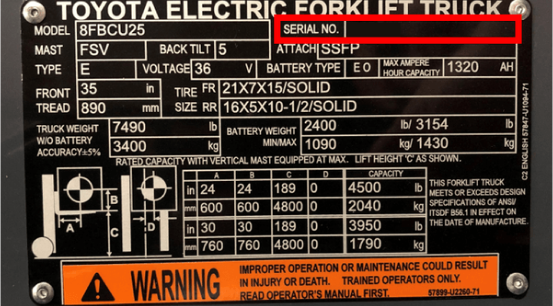How to Find Your Equipment Model Number.
Finding the right parts for your equipment is easy when you have your model and serial number which can be found on the data plate. Luckily, a forklift data plate is installed on every truck on the market to help you understand what your forklift can do and provide vital information.
Model Number: The model number of your toyota forklift is extremely important for relaying information to your dealers about repair or technical assistance and for looking up replacements part!
Serial Number: The serial number on your lift is the most important number.The model serial number combination will allow us to provide you with the parts that will fit your particular piece of equipment.

How to Find Your Equipment Serial Number
Finding the right parts for your equipment is easy when you have your model and serial number which can be found on the data plate. Luckily, a forklift data plate is installed on every truck on the market to help you understand what your forklift can do and provide vital information.
Model Number: The model number of your toyota forklift is extremely important for relaying information to your dealers about repair or technical assistance and for looking up replacements part!
Serial Number: The serial number on your lift is the most important number.The model serial number combination will allow us to provide you with the parts that will fit your particular piece of equipment.

Need some help? For further assistance or more information, contact your local Toyota Dealer.

Please click below to sign in to your MyToyota account
Don't have an account?
When to Use: Electric Pallet Jack vs. Manual Pallet Jack

Toyota’s full line of equipment ranges from the small but sturdy hand pallet truck to the colossal beasts that make up our line of container handlers. Oftentimes, load capacity and application needs will determine the best type of material handling equipment you’ll need. But sometimes the decision may be a bit more subtle.
A Toyota Hand Pallet Truck (HPT) may be exactly what you need to get the job done for smaller applications – but a Toyota Electric Walkie Pallet Jack might work just as well. The load capacity between these two products isn’t much different. The HPT’s capacity weighs in at 5,500 pounds while the Electric Walkie maxes out at 4,500. How do you decide between the two?
Electric Pallet Jack vs. Manual Pallet Jack
Using a Toyota Hand Pallet Truck
While the HPT can lift a higher capacity than the Electric Walkie, heavier loads mean more exertion from the operator, making it better suited for shorter runs and quick material handling jobs. It’s an economical option whose size makes it highly versatile and ergonomic without any of the complexities of electrical wiring or battery maintenance. It’s a great fit for retail, cold storage, and general warehousing industries!
Using a Toyota Electric Walkie
The Electric Walkie takes the strain off the operator, making it ideal for mid-distance runs and ease of operation when working on trailers, dock plates, ramps, or slopes. An electric brake comes in handy when working on a grade where you may need to stop, and the anti-rollback system conveniently assists in keeping a load stationary during a transition from braking to moving. The HPT doesn’t have a similar system, meaning that the operator must maintain the stability of the load through physical exertion or by setting the load down. On a grade, the weight can make this difficult.
A bit bigger than an HPT, this walkie is still a great fit for efficiently moving products through a warehouse and is designed with convenience in mind. Its drive motor makes it easier to navigate over dock plates and to pull and raise loads, ideal for higher-cycle applications.
Sometimes it’s the small things that make a big difference. If you’re not sure which product is the best match for your operation, feel free to reach out to your local Toyota Forklift Dealer for more information.